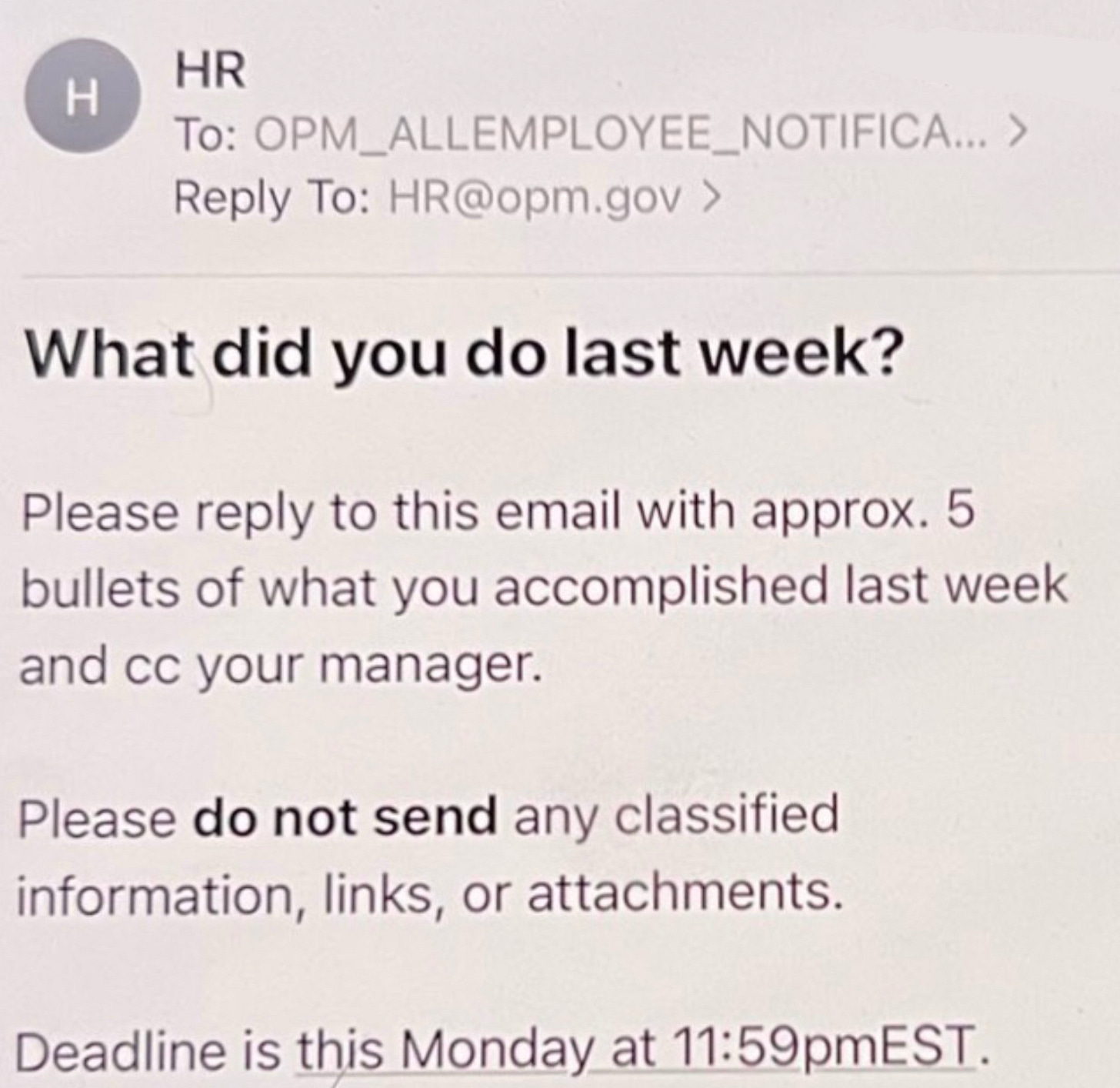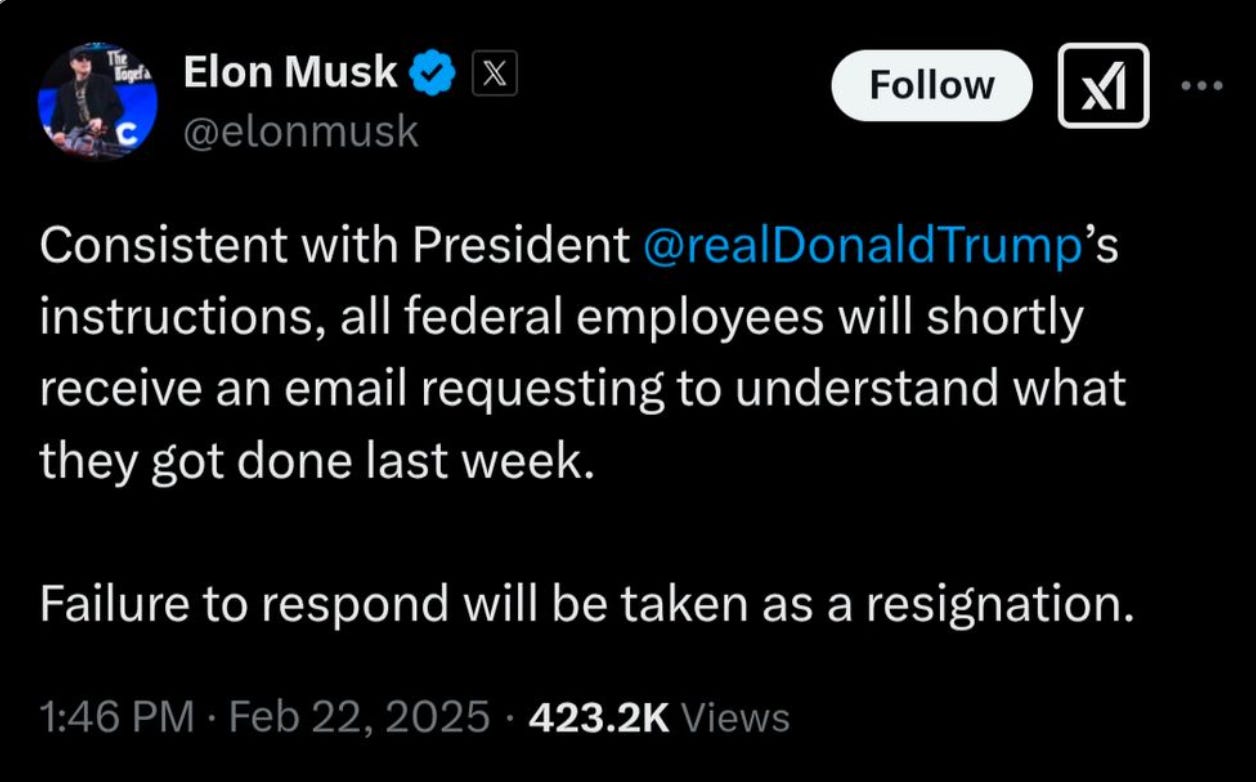Military Purges and Complacent Judges
Plus: What I wrote in The Atlantic about the assault on public employees
I wrote in The Atlantic about Trump’s assault on public employees. You can read the full piece here, excerpts below.
President Donald Trump and his billionaire adviser Elon Musk justify dismantling the civil service as cost cutting. The federal government has “billions and billions of dollars in waste, fraud, and abuse,” Trump claimed earlier this month, and Musk has complained about a “staggering amount of waste of taxpayer money.” Their actions—a barrage of executive orders, memos, layoffs, and attempts to unilaterally eliminate entire agencies—have sparked outrage, but Musk sees that only as proof of their achievements: “They wouldn’t be complaining so much if we weren’t doing something useful.”
To start, let’s dispense with the notion that the government is too big. It is not. As a share of the workforce, federal employment has declined in the past several decades. Civilian employees represent about 1.5 percent of the population and account for less than 7 percent of total government spending. According to the nonpartisan Partnership for Public Service, seven out of 10 civilian employees work in organizations that deal with national security, including departments—such as Veterans Affairs and Homeland Security—that the public supports.
The reality is that the federal government has long faced a human-capital crisis. Since 2001, the nonpartisan Government Accountability Office has classified human-capital management—the number of people who are successfully recruited to fill skilled positions—as an area of “high risk” for the federal government. The workforce is older than the private sector, and the federal government already has a hard time hiring people.
The Trump administration has created a toxic work environment. I’ve spent 25 years studying public administration and have never seen anything like the deep sense of dread that federal employees are now experiencing. I spoke with workers who feared reprisal if their names were published. One told me that there’s an “eerie” mood in the Census Bureau office: “No one can openly discuss anything.” Another civil servant said that people who’ve worked in the U.S. Attorney’s Office for decades are afraid and “can’t believe what’s happening.”
Their exit will be our loss. We rely on public employees every day, usually not noticing how they make our lives better. The costs of dismantling agencies, dramatically politicizing state capacity, and demeaning the idea of public service will still be counted long after Trump has departed the scene.
Unfortunately, the trends I identified are not stopping. Within weeks, the Trump administration will start issuing large scale Reductions In Force for non-probationary employees, arguing that many of the functions it dislikes no longer need employees.
Military Purges…
Back in December I wrote about the the possibility that Trump would pursue and unprecedented politicization of the military by purging its senior officers. Well, it happened. The Joint Chiefs of Staff, Charles Q. Brown Jr, Adm. Lisa Franchetti, the who lead the Navy; and Gen. James Slife, the vice chief of the Air Force, were all pushed out. Some takeaways.
Three senior officers were let go. The two most senior were a Black man and White woman. This reflects an ethos among the Trump administration that DEI is not just training programs, but the presence of non-White males in senior positions. Brown is being replaced by a three star general, who may need a Congressional waiver because he lacks sufficient experience as a commander. It reflects a pattern of less experienced and qualified White men replacing Black men: Hegseth replacing Lyold Austen, and Trump replacing Obama.
Can the President do this? As I wrote before, the short answer is yes.
As Commander-in-Chief, Presidents have considerable discretion in how they can shape military personnel. The fact that they have not used it in the past is a testament to the bipartisan respect that the military holds. Previous presidents did not see any need or advantage to politicize its ranks, and would have been pilloried for doing so. But Trump, in this way as in so many others, is different.
In other words, Trump is breaking norms here, not laws.
The other three who were removed were lawyers, the Judge Advocates General for the Army, Navy and Air Force. Why them? They are not involved in any conflicts. Why are they as important as the Joints Chief of Staff? The answer is that this is part of a broader pattern where Trump has been targeting General Counsels and other lawyers across government. It has long been part of his second-term strategy for governing.
Having loyalist lawyers in place will make it much harder for military officers to resist Trump’s orders. Hegseth has been critical of military lawyers constraining officers in the field. In practical terms, this might result in a legal blessing and greater practice of what is commonly regarded as war crimes. Hegseth’s selection for Secretary of Defense came after he lobbied Trump to pardon convicted war criminals. Now it is simply less likely they would be prosecuted. Military loyalist lawyers can also greenlight the use of military as a domestic police force, by invoking the Insurrection Act.
Authoritarians focus on controlling the bureaucracy, but especially the legal system and national security system. Whatever else Hegseth says about readiness or DEI, Trump’s military purges are about control. This may be only the start of a series of actions to build an American military centered on loyalty to Trump.
…and Complacent Judges
At this point, we are putting a great deal of hope in the judicial branch. A good measure is how many judges put emergency injunctions in place to stop harm from occurring before they rule on the legality of the actions. We are seeing such orders. On the other hand, we are also seeing judges allowing the Trump administration to move forward based on the faulty assumption that they are operating under normal conditions.
My Ford School colleague Sam Bagenstos is writing on this topic. Sam served as General Counsel at the Office of Management and Budget, and the Department of Health and Human Services. He described one case where an Obama appointee Judge Casey Cooper denied a plea from unions for a restraining order against probationary firings.
The Judge’s decision misses the mark for two reasons. First, the immediate harms significantly outweigh the benefits. Mass firings cannot be undone. They damage agency capacity and those who are fired move on with their lives. That is a strong argument for a pause in action.
Second, the Judge is acting as if employees can get a fair hearing in the Trump administration when it is very clear that internal processes are also being politicized. The Judge pointed employees to the Federal Labor Relations Authority, a body within the executive branch that judges on claims of unfair treatment by employees. But Trump is also politicizing that body. He illegally has fired its head, as he had with the Merit Systems Protection Board, another internal body for federal employees to plead their case. The bottom line is that employees cannot expect timely of fair treatment without the courts. This should be clear enough to judges.
In other cases, judges have said that unions lack standing to represent their members, even as public employees very much want them to. This broader approach normalizes mass purges and government shutdowns by converting them into routine workplace personnel disputes between individual employees and the administration. In doing so, the Judges empower the administration.
Let me give you another example. U.S. District Judge Carl Nichols (a Trump appointee) just allowed the administration to place the USAID workforce on administrative leave:
Weighing plaintiffs’ assertions on these questions against the government’s is like comparing apples to oranges. Where one side claims that USAID’s operations are essential to human flourishing and the other side claims they are presently at odds with it, it simply is not possible for the Court to conclude, as a matter of law or equity, that the public interest favors or disfavors an injunction.
But the Judge does not have to weigh on these competing claims. Presidents putting employees on administrative leave like this, impounding funds and shutting down agencies are all pretty clearly illegal. See this piece by Nick Bednar on administrative leave, which is meant to be used “sparingly” according to Congress, not as a backdoor means to shut down agencies. Those are compelling reasons to stay the actions!
Judge Nichols determined that putting people on leave was essential to the Trump administration’s goals of reviewing USAID. The logic here is baffling. The review can take place if the employees remain in their office or at their overseas station. The reality is that Trump is not engaged in a review of the operations. If they were, they would be talking to the people who know the operations best, rather than locking them out of their offices.
Nichols directed employees to civil service review boards such as the Foreign Service Grievance Board and the Merit Systems Protection Board. But as noted above Trump is trying to convert those boards into partisan firing machines. The sheer scale of employees fired means that such boards, which typically focus on individual cases, cannot provide timely help. According to Nichols, the employees can always “hear a retrospective claim that agency defendants had engaged in an unfair labor practice by shuttering the agency.” To what end? Their agency and jobs will have been removed in the meantime.
Judge Nichols questioned the “alleged unlawful dismantling” of USAID noting that “at present, the agency is still standing.” They literally have removed the signs! Trump’s plan is to reduce the agency from 10,000 to 300. Employees cannot get to their office. How, exactly, is the agency still standing?
Here is another potential future example. Musk has said that failure to respond to his email requests will be “taken as a resignation.” This is plainly illegal — resignations must be voluntary.
One federal employee told me:
I just received the hr email asking for 5 things I did last week. This is a freaking trap because no matter what we respond, it can and likely will be used against us. If I want to resign, there is a process. If they want to fire me, there is a process. My colleagues are freaking out about this rightly so.

If DOGE can stop salary payments, and lock federal employees out of their workplaces, those employees are effectively fired. Will a judge tell these employees to take it up personnel review boards with the Trump administration to resolve their complaints before seeking legal remedy? It sounds insane, but that has been the position of the courts thus far.
Judges can’t sit on the sidelines while the Trump administration illegally changes the facts on the ground. They need to see the broader context and moment we are in, and use their discretion in a way that will halt the processes of democratic backsliding we are witnessing now.
If you are interested in this topic, the Association of Public Policy and Management will be hosting a webinar next week. Free registration required.







